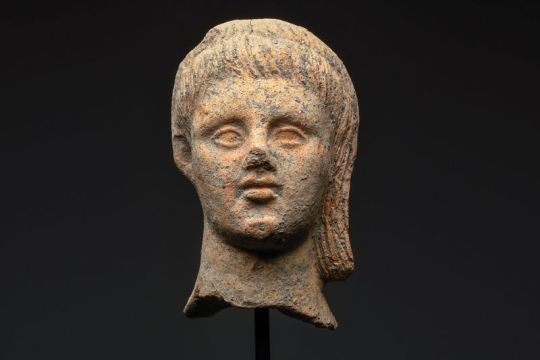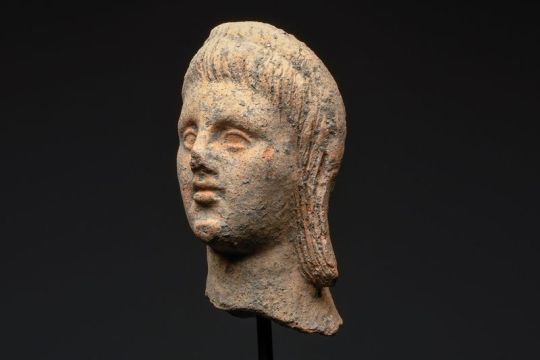#minerva x pater
Photo

Dimi's parents Minerva and Pater.
... wait. Her biological parents. Drawn by @myriamsaviniart
#queen minerva#minerva#minerva rp#minerva royal punch#pater#King Pater#Pater the Human#Royal Punch#rp#waeziverse#fantasy#pater x Minerva#minerva x pater
29 notes
·
View notes
Text




Etruscan terracotta head of a young male 4th-3rd C. BCE. 8-1/4 inches High. Ex. old collection of Dr. Angelo R. Bergamo, N.J.
"This wide territory was divided into three grand districts — that in the centre, which may be termed Etruria Proper; that to the north, or Etruria Circumpadana; and that to the south, or Etruria Campaniana. And each of these regions was divided into Twelve States, each represented by a city...
In Etruria Circumpadana there were Twelve cities. Liv. V.33; Serv. ad Virg. Aen. X.202. Plutarch (Camillus) however, asserts that there were eighteen cities of commercial and manufacturing importance in this region of Etruria. The capital appears to have been Mantua (Virg. Aen. X.203; Serv. ad Aen. X.202), though Pliny asserts that Felsina, now Bologna, was intitled to that honour. Plin. III.20; cf. Liv. XXXVII.57. A third city was Melpum, of which we know no more than that it stood north of the Po, was renowned for its wealth, and was destroyed by the Gauls on the same day that Camillus captured Veii. Corn. Nepos, ap. Plin. III.21. Atria, or Adria, was a noble city and port of the Etruscans which gave its name to the Adriatic sea. Plin. III.20; Liv. V.33; Strabo, V.p214; Varro, Ling. Lat. V.161; Fest. v. Atrium. The notices of Justin (XX.1), and Stephanus (sub voce) are referred by Müller to the Hadria of Picenum. Etrusk. einl. 3, 4; cf. Cramer, Anc. Italy, I. p116. And Spina, at the mouth of the Po, though called a Greek city, was certainly a Pelasgic settlement, as Dionysius (I. p15, ed. Sylb.) affirms, and probably also Etruscan. See Niebuhr, I. p36; Müller, Etrusk. einl. 3, 4. Müller thinks, from Strabo's notice of it (V. p214), that Ravenna is to be regarded as an Etruscan site; and Cupra in Picenum was probably so, for its temple was built by the Etruscans and named after their Goddess, Cupra, or Juno. Strabo, V.p241. Yet Niebuhr (I. p48) refers this statement to the Tyrrhene-Pelasgi, not to the Etruscans. We know the names of no other Etruscan cities beyond the Apennines.
There were Twelve chief cities also in Etruria Campaniana. Liv. V.33; Strabo, V.p242. The metropolis was Capua, built by the Etruscans 800 years before Christ, and called by them Vulturnum. Strabo, loc. cit.; V. Paterc. I.7; Liv. IV.37; Mela, II.4; Serv. ad Aen. X.145. Nola also was of Etruscan foundation. Vell. Pater. loc. cit. Dicaearchia, or Puteoli (Pausan. IV.35, VIII.7; Steph. Byz. v. Ποτίολοι), Pompeii, Herculaneum (Strabo, V.p247), and Nuceria (Philistos, cited by Müller, einl. 4, 2) were all once possessed by the Etruscans; and Marcina in the Gulf of Paestum was built by them. Strabo, V. p251. Surrentum, also, from the temple of the Etruscan Minerva on its promontory, must have belonged to that people (Stat. Sylv. II.2, 2; Steph. Byz. sub voce); and Müller (Etrusk. einl. 4, 2) would also incl Salernum. Niebuhr (I p73 et seq.), however, considers most of what is said of the Etruscan possessions south of the Tiber to refer to the Tyrrhene-Pelasgi, not to the Etruscans, properly so called."
-George Dennis, The Cities and Cemeteries of Etruria: Introduction note 11
https://paganimagevault.blogspot.com/2020/04/etruscan-terracotta-head-of-young-male.html
#etruscan#rasenna#european art#pagan#europe#european history#paganism#antiquities#antiquity#italy#ancient#sculpture#statue#literature#history#art#4th century bce#3rd century bce
5 notes
·
View notes